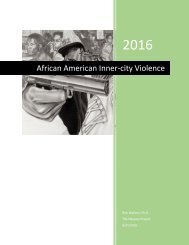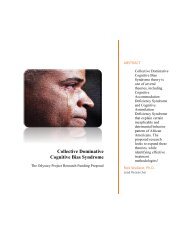U.S. Justice Department Report on the Ferguson Police Department
Ferguson’s law enforcement practices are shaped by the City’s focus on revenue rather than by public safety needs. This emphasis on revenue has compromised the institutional character of Ferguson’s police department, contributing to a pattern of unconstitutional policing, and has also shaped its municipal court, leading to procedures that raise due process concerns and inflict unnecessary harm on members of the Ferguson community.
Ferguson’s law enforcement practices are shaped by the City’s focus on revenue rather than by public safety needs. This emphasis on revenue has compromised the institutional character of Ferguson’s police department, contributing to a pattern of unconstitutional policing, and has also shaped its municipal court, leading to procedures that raise due process concerns and inflict unnecessary harm on members of the Ferguson community.
Create successful ePaper yourself
Turn your PDF publications into a flip-book with our unique Google optimized e-Paper software.
subject pulled away from <strong>the</strong> officer but did not o<strong>the</strong>rwise actively resist arrest, attempt to flee,<br />
or pose an immediate threat).<br />
Indeed, officers’ unreas<strong>on</strong>able ECW use violates FPD’s own policies. The department<br />
prohibits <strong>the</strong> use of force unless reas<strong>on</strong>able alternatives have been exhausted or would clearly be<br />
ineffective. FPD General Order 410.01. A separate ECW policy describes <strong>the</strong> weap<strong>on</strong> as<br />
“designed to overcome active aggressi<strong>on</strong> or overt acti<strong>on</strong>s of assault.” FPD General Order<br />
499.00. The policy states that an ECW “will never be deployed punitively or for purposes of<br />
coerci<strong>on</strong>. It is to be used as a way of averting a potentially injurious or dangerous situati<strong>on</strong>.”<br />
FPD General Order 499.04. Despite <strong>the</strong> existence of clearly established Fourth Amendment case<br />
law and explicit departmental policies in this area, FPD officers routinely engage in <strong>the</strong><br />
unreas<strong>on</strong>able use of ECWs, and supervisors routinely approve <strong>the</strong>ir c<strong>on</strong>duct.<br />
It is in part FPD officers’ approach to policing that leads <strong>the</strong>m to violate <strong>the</strong> C<strong>on</strong>stituti<strong>on</strong><br />
and FPD’s own policies. Officers across <strong>the</strong> country encounter drunkenness, passive defiance,<br />
and verbal challenges. But in Fergus<strong>on</strong>, officers have not been trained or incentivized to use deescalati<strong>on</strong><br />
techniques to avoid or minimize force in <strong>the</strong>se situati<strong>on</strong>s. Instead, <strong>the</strong>y resp<strong>on</strong>d with<br />
impatience, frustrati<strong>on</strong>, and disproporti<strong>on</strong>ate force. FPD’s weak oversight of officer use of force,<br />
described in greater detail below, facilitates this abuse. Officers should be required to view <strong>the</strong><br />
ECW as <strong>on</strong>e tool am<strong>on</strong>g many, and “a weap<strong>on</strong> of need, not a tool of c<strong>on</strong>venience.” 2011 ECW<br />
Guidelines at 11. Effective policing requires that officers not depend <strong>on</strong> ECWs, or any type of<br />
force, “at <strong>the</strong> expense of diminishing <strong>the</strong> fundamental skills of communicating with subjects and<br />
de-escalating tense encounters.” Id. at 12.<br />
b. FPD’s Use of Canines <strong>on</strong> Low-level, Unarmed Offenders Is Unreas<strong>on</strong>able<br />
FPD engages in a pattern of deploying canines to bite individuals when <strong>the</strong> articulated<br />
facts do not justify this significant use of force. The department’s own records dem<strong>on</strong>strate that,<br />
as with o<strong>the</strong>r types of force, canine officers use dogs out of proporti<strong>on</strong> to <strong>the</strong> threat posed by <strong>the</strong><br />
people <strong>the</strong>y encounter, leaving serious puncture wounds to n<strong>on</strong>violent offenders, some of <strong>the</strong>m<br />
children. Fur<strong>the</strong>rmore, in every canine bite incident for which racial informati<strong>on</strong> is available, <strong>the</strong><br />
subject was African American. This disparity, in combinati<strong>on</strong> with <strong>the</strong> decisi<strong>on</strong> to deploy<br />
canines in circumstances with a seemingly low objective threat, suggests that race may play an<br />
impermissible role in officers’ decisi<strong>on</strong>s to deploy canines.<br />
FPD currently has four canines, each assigned to a particular canine officer. Under FPD<br />
policy, canines are to be used to locate and apprehend “dangerous offenders.” FPD General<br />
Order 498.00. When offenders are hiding, <strong>the</strong> policy states, “handlers will not allow <strong>the</strong>ir K-9 to<br />
engage a suspect by biting if a lower level of force could reas<strong>on</strong>ably be expected to c<strong>on</strong>trol <strong>the</strong><br />
suspect or allow for <strong>the</strong> apprehensi<strong>on</strong>.” Id. at 498.06. The policy also permits <strong>the</strong> use of a<br />
canine, however, when any crime—not just a fel<strong>on</strong>y or violent crime—has been committed. Id.<br />
at 498.05. This permissiveness, combined with <strong>the</strong> absence of meaningful supervisory review<br />
and an apparent tendency to overstate <strong>the</strong> threat based <strong>on</strong> race, has resulted in avoidable dog<br />
bites to low-level offenders when o<strong>the</strong>r means of c<strong>on</strong>trol were available.<br />
In December 2011, officers deployed a canine to bite an unarmed 14-year-old African-<br />
American boy who was waiting in an aband<strong>on</strong>ed house for his friends. Four officers, including a<br />
31

















